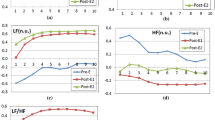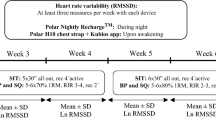Abstract
The aim of the study was to evaluate the effectiveness of the Poincaré plot analysis of heart rate variability (HRV) in observing endurance training-induced changes. Four 10-min manoeuvres were performed (supine lying, standing, steady state exercising and subsequent recovery) by eight control subjects before and after a short-term endurance training and by eight subjects trained for at least 3 years. HRV was assessed by traditional time- and frequency-domain indexes, in parallel with the Poincaré plot analysis. In the latter each R-R interval is plotted as a function of the previous one, and the standard deviations of the instantaneous and long-term R-R interval variability are calculated. In our subjects, the Poincaré scatter grams became gradually narrower from supine to exercising, with progressive parasympathetic withdrawal. Short- and long-term endurance training led to higher aerobic power (p<0.05) and ventilatory threshold shifted towards higher power output (p<0.05). All HRV evaluation methods showed that HRV values were higher after training both during supine lying and standing (p<0.05). The Poincaré scatter grams were wider in the trained state. Standard deviations of the Poincaré plot were significantly correlated with the main parameters of the time- and frequency-domain analyses, especially concerning the parasympathetic indicators. These results suggested that Poincaré plot parameters as well as the "width" of the scatter gram could be considered as surrogates of time- and frequency-domain analysis to assess training-induced changes in HRV.

Similar content being viewed by others
References
Bahjaoui-Bouhaddi M, Cappelle S, Henriet MT, Dumoulin G, Wolf JP, Regnard J (2000) Graded vascular autonomic control versus discontinuous cardiac control during gradual upright tilt. J Auton Nerv Syst 79:149–155
Bernardi L, Leuzzi S, Radaelli A, Passino C, Johnston JA, Sleight P (1994) Low-frequency spontaneous fluctuations of R-R interval and blood pressure in conscious humans: a baroreceptor or central phenomenon? Clin Sci (Lond) 87:649–654
Bigger JT Jr., Fleiss JL, Steinman RC, Rolnitzky LM, Kleiger RE, Rottman JN (1992) Correlations among time and frequency domain measures of heart period variability two weeks after acute myocardial infarction. Am J Cardiol 69:891–898
Braun C, Kowallik P, Freking A, Hadeler D, Kniffki KD, Meesmann M (1998) Demonstration of nonlinear components in heart rate variability of healthy persons. Am J Physiol 275:H1577–H1584
Brown TE, Beightol LA, Koh J, Eckberg DL (1993) Important influence of respiration on human R-R interval power spectra is largely ignored. J Appl Physiol 75:2310–2317
Carrasco S, Gaitan MJ, Gonzalez R, Yanez O (2001) Correlation among Poincare plot indexes and time and frequency domain measures of heart rate variability. J Med Eng Technol 25:240–248
Casadei B, Cochrane S, Johnston J, Conway J, Sleight P (1995) Pitfalls in the interpretation of spectral analysis of the heart rate variability during exercise in humans. Acta Physiol Scand 153:125–131
Cooke WH, Cox JF, Diedrich AM, Taylor JA, Beightol LA, Ames JEt, Hoag JB, Seidel H, Eckberg DL (1998) Controlled breathing protocols probe human autonomic cardiovascular rhythms. Am J Physiol 274:H709–H718
De Vito G, Galloway SD, Nimmo MA, Maas P, McMurray JJ (2002) Effects of central sympathetic inhibition on heart rate variability during steady-state exercise in healthy humans. Clin Physiol Funct Imaging 22:32–38
Dixon EM, Kamath MV, McCartney N, Fallen EL (1992) Neural regulation of heart rate variability in endurance athletes and sedentary controls. Cardiovasc Res 26:713–719
Furlan R, Piazza S, Dell'Orto S, Gentile E, Cerutti S, Pagani M, Malliani A (1993) Early and late effects of exercise and athletic training on neural mechanisms controlling heart rate. Cardiovasc Res 27:482–488
Gimenez M, Servera E, Salinas W (1982) Square-wave endurance exercise test (SWEET) for training and assessment in trained and untrained subjects. I. Description and cardiorespiratory responses. Eur J Appl Physiol 49:359–368
Hull SS Jr., Vanoli E, Adamson PB, Verrier RL, Foreman RD, Schwartz PJ (1994) Exercise training confers anticipatory protection from sudden death during acute myocardial ischemia. Circulation 89:548–552
Israel S (1976) The problems of overtraining in a medical and sports physiological point of view (Zur Problematik des Übertrainings aus internistischer und leistungsphysiologischer Sicht). Med Sport 16:1–12
Janssen MJ, de Bie J, Swenne CA, Oudhof J (1993) Supine and standing sympathovagal balance in athletes and controls. Eur J Appl Physiol 67:164–167
Kamath MV, Fallen EL, McKelvie R (1991) Effects of steady state exercise on the power spectrum of heart rate variability. Med Sci Sports Exerc 23:428–434
Kamen PW, Krum H, Tonkin AM (1996) Poincare plot of heart rate variability allows quantitative display of parasympathetic nervous activity in humans. Clin Sci (Lond) 91:201–208
Loimaala A, Huikuri H, Oja P, Pasanen M, Vuori I (2000) Controlled 5-mo aerobic training improves heart rate but not heart rate variability or baroreflex sensitivity. J Appl Physiol 89:1825–1829
Macor F, Fagard R, Amery A (1996) Power spectral analysis of RR interval and blood pressure short-term variability at rest and during dynamic exercise: comparison between cyclists and controls. Int J Sports Med 17:175–181
Melanson EL, Freedson PS (2001) The effect of endurance training on resting heart rate variability in sedentary adult males. Eur J Appl Physiol 85:442–449
Molgaard H, Sorensen KE, Bjerregaard P (1991) Attenuated 24-h heart rate variability in apparently healthy subjects, subsequently suffering sudden cardiac death. Clin Auton Res 1:233–237
Myers G, Workman M, Birkett C, Ferguson D, Kienzle M (1992) Problems in measuring heart rate variability of patients with congestive heart failure. J Electrocardiol 25:214–219
Nakamura Y, Yamamoto Y, Muraoka I (1993) Autonomic control of heart rate during physical exercise and fractal dimension of heart rate variability. J Appl Physiol 74:875–881
Pagani M, Lombardi F, Guzzetti S, Rimoldi O, Furlan R, Pizzinelli P, Sandrone G, Malfatto G, Dell'Orto S, Piccaluga E et al (1986) Power spectral analysis of heart rate and arterial pressure variabilities as a marker of sympatho-vagal interaction in man and conscious dog. Circ Res 59:178–193
Perini R, Orizio C, Baselli G, Cerutti S, Veicsteinas A (1990) The influence of exercise intensity on the power spectrum of heart rate variability. Eur J Appl Physiol 61:143–148
Pomeranz B, MacAulay RJB, Caudill MA, Kutz I, Adam D, Gordon D, Kilborn KM, Barger AC, Shannon DC, Cohen RJ, Benson H (1985) Assessment of autonomic function in humans by heart rate spectral analysis. Am J Physiol 248:H151–H153
Skinner JE, Molnar M, Vybiral T, Mitra M (1992) Application of chaos theory to biology and medicine. Integr Physiol Behav Sci 27:39–53
Task Force of the European Society of Cardiology and the North American Society of Pacing and Electrophysiology (1996) Heart rate variability: standards of measurement, physiological interpretation and clinical use. Circulation 93:1043–1065
Tsuji H, Venditti FJ Jr., Manders ES, Evans JC, Larson MG, Feldman CL, Levy D (1994) Reduced heart rate variability and mortality risk in an elderly cohort. The Framingham Heart Study. Circulation 90:878–883
Tulppo MP, Makikallio TH, Takala TE, Seppanen T, Huikuri HV (1996) Quantitative beat-to-beat analysis of heart rate dynamics during exercise. Am J Physiol 271:H244–H252
Tulppo MP, Makikallio TH, Seppanen T, Laukkanen RT, Huikuri HV (1998) Vagal modulation of heart rate during exercise: effects of age and physical fitness. Am J Physiol 274:H424–H429
Wasserman K (1986) The anaerobic threshold: definition, physiological significance and identification. Adv Cardiol 35:1–23
Woo MA, Stevenson WG, Moser DK, Middlekauff HR (1994) Complex heart rate variability and serum norepinephrine levels in patients with advanced heart failure. J Am Coll Cardiol 23:565–569
Yamamoto Y, Hughson RL (1991) Coarse-graining spectral analysis: new method for studying heart rate variability. J Appl Physiol 71:1143–1150
Yamamoto Y, Hughson RL, Peterson JC (1991) Autonomic control of heart rate during exercise studied by heart rate variability spectral analysis. J Appl Physiol 71:1136–1142
Acknowledgements
We thank the subjects for their reliable and cheerful contribution. This work was funded by the granting of the EA 479 by the Ministère de l'Education Nationale, de la Recherche et de la Technologie.
Author information
Authors and Affiliations
Corresponding author
Rights and permissions
About this article
Cite this article
Mourot, L., Bouhaddi, M., Perrey, S. et al. Quantitative Poincaré plot analysis of heart rate variability: effect of endurance training. Eur J Appl Physiol 91, 79–87 (2004). https://doi.org/10.1007/s00421-003-0917-0
Accepted:
Published:
Issue Date:
DOI: https://doi.org/10.1007/s00421-003-0917-0




